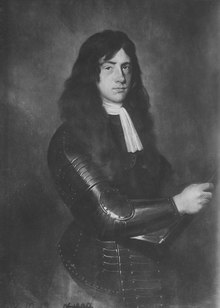Johann Karl (Pfalz-Gelnhausen)
Johann Karl von Pfalz-Gelnhausen (born October 17, 1638 in Bischweiler ; † February 21, 1704 in Gelnhausen ) was Count Palatine near Rhine, Duke in Baiern, from Pfalz-Zweibrücken-Birkenfeld to Gelnhausen , Count to Veldenz and to Sponheim . He is the founder of the line of dukes in Bavaria .
Life
Johann Karl was the youngest son of Count Palatine Christian I of Zweibrücken-Birkenfeld-Bischweiler from his marriage to Magdalena Katharina (1606–1648), daughter of Count Palatine and Duke Johann II of Zweibrücken . Together with his older brother Christian , he was trained by Philipp Jacob Spener and later studied at the University of Strasbourg . Then the brothers undertook a 5-year cavalier tour that took them to France, Holland, England, Sweden and Switzerland, among others.
As a Swedish cavalry colonel, he took part in the war against Denmark at the side of his distant cousin Charles X of Sweden and later fought against the Turks in Hungary. In Dutch service he took part in the Battle of Seneffe in 1674 and received the rank of first military leader. Then he left military service and retired to Gelnhausen. This was given to him as a deputate in contracts with his brother Christian in 1681 and 1683 . In Gelnhausen he acquired the so-called Fürstenhof, which was equipped with land and gardens.
Marriages and offspring
Johann Karl married Sophie Amalie von Pfalz-Zweibrücken (December 15, 1646 - November 20, 1695), daughter of Count Palatine Duke Friedrich von Zweibrücken and widow of Count Siegfried von Hohenlohe-Weikersheim (born August 28, 1685) in Weikersheim's first marriage in 1685 1619 - April 26, 1684), with whom he had a daughter:
- Magdalene Juliane (born February 21, 1686; † November 5, 1720) ⚭ 1704 Duke Joachim Friedrich of Schleswig-Holstein-Plön (1668–1722)
After the death of his first wife, he morganatically married Esther-Maria von Witzleben (1665–1725), the daughter of Baron Georg Friedrich von Witzleben zu Elgersburg, on July 28, 1696 . He signed a succession agreement with his brother Christian. He then endeavored to raise his wife to the rank of imperial countess and so repeal the contract, but died before he achieved his goal. His widow sued the Reichshofrat in 1708. In 1715 she and her children were granted all privileges, so that the succession of the later (1799) dukes in Bavaria could exist. The couple had the following children:
- Friedrich Bernhard (1697–1739) ⚭ 1737 Princess Ernestine Luise von Waldeck (1705–1782)
- Johann (1698–1780) ⚭ Countess Sophie Charlotte von Salm-Dhaun (1719–1770)
- Wilhelm (January 4, 1701 - December 25, 1760), Hungarian field marshal, Dutch general of the cavalry
- Charlotte Katharina (* December 19, 1699; † May 11, 1785) ⚭ 1745 Prince Friedrich Wilhelm zu Solms-Braunfels (1696–1761)
- Sophie Marie (April 5, 1702 - November 13, 1761) ⚭ 1722 Count Heinrich XXV. Reuss to Gera (1681–1748)
literature
- Nathanael von Schlichtegroll: Genealogical life-sketches of the ancestors of the Bavarian royal house up to Otto the Great von Wittelsbach , J. Rösl, 1842, p. 57
- Johann Samuelersch: General Encyclopedia of Sciences and Arts: in alphabetical order. Section 2, H-N; Theil 21, Johann (Infant von Castilien) - Johann-Boniten , part 2, volume 21, Gleditsch, 1842, p. 189
- Maximilian V. Sattler: Textbook of Bavarian History , Lindauer, 1868, p. 412 digitized
- Philipp Kasimir von Heintz : The former principality of Pfalz-Zweybrücken and its dukes , p.109f
- History of the von Witzleben family ›The Elgersburg Line› Second Division. The Elgersburger line. ›Descendants of Count Palatine Johann Carl zu Birkenfeld-Gelnhausen, family tree
Web links
Individual evidence
- ↑ Michael Masson: Das Königshaus Bayern , Verl. Des Hrsg., 1854, p. 168
| personal data | |
|---|---|
| SURNAME | Johann Karl |
| BRIEF DESCRIPTION | Count Palatine of Pfalz-Gelnhausen |
| DATE OF BIRTH | October 17, 1638 |
| PLACE OF BIRTH | Bischwiller |
| DATE OF DEATH | February 21, 1704 |
| Place of death | Gelnhausen |
